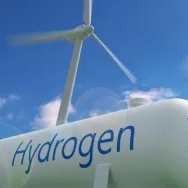What is green methanol and what is it used for?
Green methanol is a synthetic fuel produced from green hydrogen and non-fossil carbon, captured from the atmosphere or generated from agricultural and forestry waste.
Among its advantages, in addition to reducing emissions compared to traditional fossil fuels, is that it is a liquid at room temperature, making it easy to store and transport.
Methanol can be used as a raw material in some of the most challenging sectors to decarbonize, such as sea and air transportation or the chemical industry.
In sea transportation, it’s being considered as one of the renewable fuels of the future. Its use will require the construction of new ships or the adaptation of existing engines, as well as modifying storage and distribution systems in ports. In air transportation, it can be used to produce e-SAF, sustainable synthetic aviation fuel. This e-SAF can be blended with traditional kerosene without needing to modify aircraft engines.
This renewable fuel will contribute to achieving European emission reduction goals outlined in regulations such as "ReFuelEU Aviation" and "FuelEU Maritime," as well as those set by the International Maritime Organization (IMO).
Our project: Europe's largest green methanol plant
As part of the Andalusian Green Hydrogen Valley, in collaboration with C2X, we’re going to build Europe's largest green methanol plant in the Port of Huelva. With an investment of up to 1 billion euros, it’ll be one of the five largest green methanol plants in the world, with an estimated annual production capacity of 300,000 tons, avoiding the emission of up to 1 million tons of CO2.
The construction of the plant, scheduled to start operating in 2028, will create 2,500 jobs, both direct and indirect, and will position Andalusia as a leading global hub in sustainable energies.
The new green methanol plant will annually produce 300,000 tons of this renewable fuel
This project strengthens the Andalusian Green Hydrogen Valley, the largest hydrogen project presented to date in Europe.
What is ammonia and what is it used for?
Green ammonia is a derivative product of green hydrogen that can be used as sustainable marine fuel and as a carrier for green hydrogen transport. Both its production, combining green hydrogen and atmospheric nitrogen, and its use as fuel are carbon-neutral.
Transporting ammonia is simpler than hydrogen because its storage doesn't require temperatures as low as those for hydrogen, and there have been ships and infrastructures dedicated to its transport for decades.
Once at the destination, the green ammonia can be converted back into green hydrogen for use in multiple industries in northern Europe, or it can be used directly as a fuel in shipping or in some industries, such as fertilizer production.
Our project: Europe's largest green ammonia plant
As part of the Andalusian Green Hydrogen Valley, we have established an alliance with Yara Clean Ammonia, allowing us to build Europe's largest green ammonia plant in the energy park of San Roque, Cádiz. With an investment of 1 billion euros, the plant will have an annual production capacity of up to 750,000 tons of ammonia and will prevent the emission of 3 million tons of CO2.
It’ll be operational by 2027, and its construction will create 3,300 jobs, including direct, indirect, and induced employment opportunities.
This strategic agreement will make it possible to establish a secure, resilient, and efficient supply chain to deliver green ammonia. It’ll enable us to begin marketing green hydrogen and ammonia to industrial and maritime clients in Rotterdam and its surrounding area, as well as other destinations in Northwest Europe.
How? Thanks to the agreement with the Port of Rotterdam to create the first green hydrogen corridor linking the south and north of Europe, connecting the ports of Algeciras and Rotterdam.
This will be the green hydrogen maritime corridor


Hydrogen is one of the main sources of renewable energy and the most abundant element in the universe.
Find out more
To drive the development of the Valley and the entire hydrogen value chain, we’ve established strategic partnerships with local, national, and international partners.
Find out more





